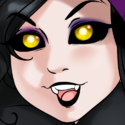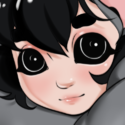Batfolk
Writer Credit
| BubbleLord |
|---|
|
Codex
Name: Batfolk.
Sexes: Male and Female.
Height: Ranges from between 4'4" and 6'2. Their average, however, is often below 5 feet tall.
Weight: Lighter than humans; comparable to harpies, the weight distribution for batfolk tends to be in their hips with lithe builds to emphasize flight. Roughly 100-140 lbs.
Skin: Batfolk have smooth skin and are almost entirely known for their pale and pinkish hues.
Hair: Batfolk have both hair and fur; all hair and fur on their body is often one or two colors at most, with the common ranges being black, gray, brown, and blonde.
Eyes: Batfolk eyes are all black; these black eyes are able to reflect low-light and give them uncharacteristically good night-vision in moonlit locations. However, sunlight or bright lights will cause the black to lighten and reveal their true eye color. Batfolk true eye colors can be any bright shading of colors, such as turquoise, yellow, red, and emerald.
Ears: Batfolk can have one of two types of ears, depending on their lineage; some of them have triangular ears that stand up tall, whilst others have round ears comparable to a mecian's.
Neck: Batfolk, depending on their heritage, can have either a smooth or fur-wreathed neck; these furry "wreathes" are often in colder climates and batfolk with ancestry in furrier interspecies partnering, while smoother necks are warmer and more "pure-blooded" batfolk.
Tails: Batfolk traditionally have tiny short-furred and mostly non-functional tails; some batfolk, however, have furless prehensile spade-tipped tails. Spaded tails are always black-skinned, while furred tails generally match the batfolk's hair color.
Lifespan: About 100 years.
Maturity: 14 years.
Description
One of Savarra's more reclusive residents, the batfolk are found generally throughout the world in any cavernous sections of hospitable temperate mountains. Batfolk commonly act as workers, messengers, and prostitutes thanks to their generally pleasant looks and sometimes bottom-heavy figures. Most batfolk have membranous skin that fits close to the arm, unfolding when they extend their arms to act as wings. Batfolk have their own local variations of ears, furs, and eyes.
Depending on where they're from and who their parents are, batfolk are identified in two categories: tippers and rounders. Batfolk that live in warmer locales often have triangular ears whilst the colder natives have round ears with thicker fur backing to them. Short and long-furs exist, with trimming and growing out allowing them to easily relocate as-needed. Additional traits vary but may include longer tongues in some individuals or an exceptionally rarer ability to overcome their sunlight sensitivity. Without the shackle of sunlight sensitivity, batfolk not only live and function in a modern daytime society but always have their true eye color visible. However, these batfolk tend to have poorer night vision than others and as such are more prone to living and interacting near the surface.
Reproduction
Male and female batfolk, despite their traditionally effeminate and light build mirroring harpies, exhibit traditional reproductive capacities seen in humans; the males have dicks that achieve an average of between 8" to 12", and the females have wide hips and supple chests. It isn't uncommon for a batfolk household to be large due to their fast reproductive cycle featuring five-month pregnancies and seasonal rutting and heats that hits them twice a year. Further still, their similarities in builds are shared further in a lack of a refractory period for males; this grants them tremendous stamina, allowing for particularly long breeding sessions that often ensure impregnation.
Adequate cross-species couplings have revealed that batfolk are a "dominant" partner with most races; this means that when impregnating and being impregnated, their children are almost exclusively born as full-blooded batfolk. The exceptions most well-documented are harpies and goblins, as harpies lay eggs that hatch as more harpies whilst goblins inherit their traits.
Echolocation & Resonance Magic
Unique to batfolk is an extremely evolved ability: echolocation. Generations beneath the surface, traveling the dark night's sky, and sneaking around to their lovers' beds in pitch black have allowed batfolk to use noise for navigation. All batfolk are born with the ability to use low, all-but-inaudible thumps of their longer tongues against their cheeks; batfolk instinctively learn to use this at about a year old, with the pitch lowering the older they get as their tongue grows in size and weight. Younger batfolk in turn have a shorter-ranged thump, making it better for communal navigation while the older batfolk can use it to lead flights and detect objects within two miles.
Though this thumping echolocation is effective for their own navigation, batfolk learn overtime to use any noise to assist their movements in the dark; some of the best thieves have been batfolk, able to hear the pitter-patter of a mouse and use its noise to map out the routes ahead. This legend started from, in fact, not a thief but a mage: a Sound Mage. One of the least known variations of magic, Resonance Magic combines both White and Black magic schools into a magic that can disorient, guide, and damage. Mages among the batfolk in this school are considered its founders due to their natural evolution for using it, with every student who walks this path choosing one of three focuses: Shrieker, Listener, and Thumpers. Shriekers, true to their name, use their voice to disorient and disrupt enemies. Listeners use their magic to improve their hearing, allowing them abilities to identify whatever they hear with near-perfect accuracy. Thumpers are able to use magical reinforcement in their mouth to create even louder bangs; these can create minor shockwaves or even powerful enough sound blasts to knock warriors off their feet. The diversity in this school of magic has made most sound mages highly flexible and unpredictable, making them a fairly common asset in organized, large-scale armies that can recruit and train them.
Culture
The cultural roots of batfolk are that of nomads. All recorded knowledge about their culture is sparse due to their ancient migrations across Savarra, dating back as one of the few pieces of information prior to the fall of Belhar. Most modern batfolk have abandoned this in light of settling near settlements of other species, where they propagate in higher numbers until they form their own districts that serve as sources for brothels and cheap labor. It isn't uncommon for the Mallachite faith to find a home among these populations, but traditionally the batfolk that still migrate practice a dual-worship of Velun and Sorra. Velun's guidance grants them havens when between mountains, whilst Sorra is prayed to whenever they take flight.
In this modern age, there are two societies of batfolk currently thriving: the Grue Clan and the Inva Clan. The Grue live in the north, where their contact with the minotaurs has made them profitable merchants whilst preserving their culture in migratory flights using the vast Deeprealms. Meanwhile, the Inva Clan use the seas north of Jassira and Tronarii as their migratory grounds. Ancient spires in the sea have been found holding the clan from time to time, where they sell their services as navigators and scouts to passing ships. Some scholars theorize that their location and the lack of conflict with orcs means that batfolk have struck deals with them, possibly even granting the orcs maps that allow them to find ripe spots for raiding.
Codex Acquisition
Only one of the conditions below must be met to unlock the Batfolk Codex entry:
- Encountering the Batfolk Muggers in the Undermountain


